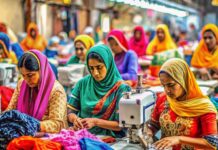In today’s ever-evolving fashion landscape, the traditional textile manufacturing sector faces formidable challenges. As fast fashion continues to dictate trends and consumer preferences, textile manufacturers must pivot swiftly to stay competitive. The demand for quicker turnaround times, enhanced product variety, and cost-effectiveness necessitates a reevaluation of longstanding practices.
Understanding the Fast-Paced Fashion Industry
Overview of Fast Fashion Trends
The fast fashion industry is characterized by its ability to rapidly produce and distribute clothing that mirrors the latest fashion trends. With consumers demanding up-to-date styles at affordable prices, fashion brands must continually innovate to keep pace. Fast fashion companies have embraced technologies that allow them to capture consumer preferences quickly and translate these insights into designs that hit the shelves almost instantaneously. This approach not only satisfies the immediate desires of fashion-savvy consumers but also encourages frequent purchases due to the constantly evolving selection of apparel.
Impact on Textile Manufacturers
For textile manufacturers, this rapid pace presents both opportunities and challenges. On the positive side, the constant demand for new fabrics and textiles can lead to increased sales and production volumes. However, traditional textile manufacturers may struggle to meet the rapid turnaround times expected by fast fashion brands. The industry’s demand for agility and flexibility requires manufacturers to reevaluate their processes to remain competitive. Failure to adapt can result in lost contracts and decreased market share.
Challenges for Traditional Textile Manufacturers
Inflexible Supply Chains
One primary challenge facing traditional textile manufacturers is their often rigid supply chain structures. Many rely on established partnerships and processes that cannot be easily altered, making it difficult to respond swiftly to changing demands. Modern supply chain management necessitates flexibility, allowing manufacturers to efficiently source materials and allocate resources based on current fashion trends and demands.
Slow Production Processes
Another hurdle is the generally slower production processes ingrained in traditional manufacturing. While fast fashion brands utilize advanced production techniques, such as on-demand manufacturing and digital textile printing, traditional manufacturers may still depend on lengthy, labor-intensive procedures. Transitioning to more agile and automated manufacturing systems can significantly reduce production times and align operations more closely with industry demands.
Managing Cash Flow
Cash flow management remains a pressing concern for those accustomed to more predictable market conditions. The cyclical nature of fast fashion sales cycles, with highs during peak seasons and lows otherwise, can create financial strains. Effective cash flow management strategies, including precise forecasting and maintaining flexible financial arrangements, are crucial for staying afloat and competitive in the fast-paced fashion landscape. This adaptability ensures that manufacturers can fund ongoing operations and investments into technology and talent development, which are vital for sustaining long-term growth and innovation.
Strategies for Adaptation
In a world where trends change at a lightning pace, traditional textile manufacturers need to adopt a flexible approach to succeed. The following strategies can help them remain competitive in the fast-paced fashion industry.
Implementing Agile Manufacturing Practices
Agile manufacturing involves designing processes that can quickly adapt to changes in demand and market conditions. By adopting agile practices, textile manufacturers can:
– Reduce lead times, enabling faster product delivery.
– Enhance customization capabilities to meet specific customer needs.
– Optimize capacity and resources to increase efficiency.
This adaptability allows manufacturers to swiftly respond to fashion trends, minimizing the risk of overproduction and stockpiling outdated inventory.
Investing in Advanced Manufacturing Technologies
Integrating advanced manufacturing technologies can transform traditional textile production. Technologies such as robotics, automation, and 3D printing streamline operations by:
– Increasing production speed and accuracy.
– Reducing labor costs through automation.
– Enhancing product quality and consistency.
Advanced technologies not only boost efficiency but also open up possibilities for innovative designs and materials that can set manufacturers apart in a crowded market.
Enhancing Supply Chain Efficiency
Efficient supply chain management is crucial for keeping pace with fast fashion. Manufacturers can enhance supply chain efficiency by:
– Implementing real-time tracking systems to monitor inventory and logistics.
– Building strong supplier relationships to ensure timely material delivery.
– Employing demand forecasting tools to better anticipate market needs.
A responsive supply chain reduces production time, lowers costs, and supports on-demand manufacturing models, ensuring that products reach consumers swiftly.
Embracing Digital Solutions
Digitalization presents significant opportunities for textile manufacturers looking to compete with the rapid pace of the fashion industry.
Advantages of Digital Textile Printing
Digital textile printing offers several benefits over traditional methods:
– Allows for short-run production, reducing waste and aligning with eco-friendly practices.
– Provides the ability to print complex designs quickly, meeting ever-changing fashion trends.
– Facilitates customizable prints, appealing to niche markets and personalized consumer preferences.
This flexibility enhances product offerings and can cater to a broader audience while reducing time and material costs.
Streamlining Fashion Product Development
Digital tools can streamline fashion product development, offering:
– Collaborative platforms that connect designers, production teams, and retailers in real-time.
– Virtual prototyping to test and refine products without physical samples.
– Rapid design iterations through computer-aided design (CAD) tools.
These digital capabilities enable faster product development cycles, reducing time-to-market and improving collaboration across the value chain.
Leveraging Data for Trend Forecasting
Data analytics is a powerful resource for predicting and responding to fashion trends:
– Manufacturers can analyze sales data, consumer behavior, and social media trends to forecast demand accurately.
– Data-driven insights help optimize inventory levels, reduce waste, and focus on popular products.
– By anticipating trends, manufacturers can introduce products that resonate with consumers, improving sales and brand loyalty.
Leveraging data ensures that textile manufacturers not only keep pace with fast-changing trends but can also drive strategic decisions with confidence.
Adopting On-Demand Manufacturing
In an industry dominated by the shifting currents of fast fashion, traditional textile manufacturers are increasingly exploring the strategic advantage of on-demand manufacturing. This approach allows companies to produce apparel in direct response to customer orders rather than predicting and producing in bulk. Such a system minimizes waste, speeds up the production cycle, and provides a more mindful approach to consumer demands and environmental impact.
Benefits of On-Demand Models
On-demand manufacturing offers a variety of benefits that traditional methods often lack. First and foremost, it reduces overproduction, significantly cutting down on excess inventory and storage costs. This not only preserves cash flow but also aligns with sustainable practices by minimizing textile waste. Additionally, the proximity of customer feedback and production allows for rapid response to emerging fashion trends, ensuring that products meet current consumer preferences with minimal delay. Moreover, on-demand systems can lead to increased customer satisfaction, as they offer tailored solutions and quicker delivery times, which are highly appealing in today’s competitive market.
Tools for Facilitating On-Demand Production
For textile manufacturers to effectively implement on-demand production, several advanced tools and technologies can be deployed. Digital textile printing, for instance, offers high customization ability and faster turnaround, which are critical to meeting rapid demand. Incorporating agile manufacturing processes enables a dynamic response to changes in fashion trends, thereby avoiding prolonged production cycles. Automation technologies and data analytics platforms are also essential, facilitating streamlined operations and precise inventory management. Additionally, integrating a sophisticated supply chain software system can enhance coordination and reduce production bottlenecks. These tools collectively empower manufacturers to produce high-quality, customized products at a pace aligned with fast fashion demands.
In conclusion, the fast-paced demands of the fashion industry present both challenges and opportunities for traditional textile manufacturers. By embracing agile manufacturing processes, leveraging digital textile printing technologies, and adopting on-demand manufacturing, businesses can enhance their adaptability to current market needs. Collaboration across the supply chain is essential to ensure a seamless transition and to meet the ever-changing fashion trends. With these strategies, textile manufacturers can maintain financial health, increase cash flow, and continue to thrive in the dynamic world of fashion.






























